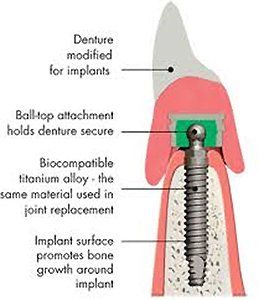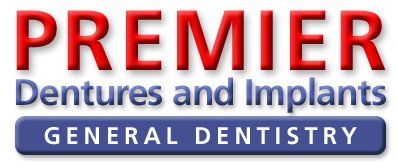Same-Day Dental Implants in the Baton Rouge Area
Dental implants are artificial tooth replacements that were first developed half a century ago by a Swedish scientist named Per-Ingvar Branemark. Implants arose from the patient’s need to secure loose-fitting dentures. Since the advent of the implant, engineering and enhancements to the implant have enabled dentists to expand the implant’s usefulness, including the replacement of missing or lost teeth. Today, implant techniques provide a wide range of tooth replacement solutions, including:
- Single tooth replacement
- Anterior replacement
- Posterior replacement
- Full upper replacement
Types of Implants
There are three main types of implants:
- The root implant
- The plate form implant
- The subperiosteal implant
The root implant – by far, the most popular – is the most effective because it mirrors the size and shape of a patient’s natural tooth. This implant is often as strong as the patient’s original tooth. The implant or artificial root is placed into the jawbone under local anesthesia, then allowed to heal and integrate with the bone. Once the healing process is completed and the jawbone is attached to the implant, the patient returns to the dental office where the implant is fitted with the new tooth. This process generally takes anywhere from three to eight months.
The plate form implant is ideal in situations where the jawbone is not wide enough to properly support a root implant. The plate form implant is long and thin, unlike the root implant, and anchors into thin jawbones. It is inserted the same way as a root implant. In certain cases, the plate form implant is immediately fitted with the restoration without waiting for the healing process to run its course.
The subperiosteal implant is used when the jawbone has receded to the point where it can no longer support a permanent implant.
Implant as a Treatment Option
If the missing tooth space has no surrounding teeth, the dentist may decide an implant is the most appropriate treatment choice or option.
The treatment plan for a bridge usually requires two trips to your dentist. Specifically, it involves:
- Numbing the surrounding teeth with a local anesthetic and cleaning plaque or decay.
- Reducing the teeth so that the crowns can be fitted.
- Making a mold or impression of the teeth in order to create a customized permanent impression (this generally takes one to two weeks).
- Fitting the patient with a temporary bridge until the permanent bridge is ready for placement.
- Removing the temporary bridge and replacing it with the permanent one.
- Adjusting the bridge for the proper bite and fit and permanently bonding it into the mouth.
Post-Implant Care
Although proper oral hygiene is always recommended for maintaining good dental health, it is especially important when a patient has received a dental implant. Bacteria can attack sensitive areas in the mouth when teeth and gums are not properly cleaned, thus causing gums to swell and jaw bones to gradually recede. Recession of the jawbone will weaken implants and eventually make it necessary for the implant to be removed. Patients are advised to visit their dentists at least twice a year to ensure the health of their teeth and implants. Dental implants can last for decades when given proper care.
Eat what you want with confidence, NOT just what you can!
Patients typically experience no more discomfort with placing an implant than extraction of the tooth which it replaces and often there is less discomfort because implants do not have nerves. Implants in there simplest forms are titanium replacements for the roots of missing teeth, however implants can offer some flexibility which teeth cannot offer as easily because 2 piece implants allow the connection of different parts called abutments which have different functions and allow flexibility for the future. Additionally, implants do not decay like teeth, so they offer greater longevity than typical tooth born restorations.
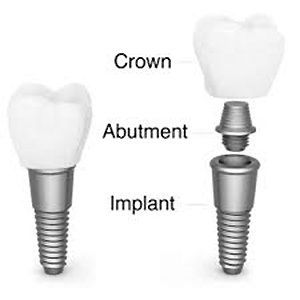
Implants Can
Stop Bone Loss
People born without teeth, a condition called Ectodermal dysplasia never form jaw bone called the alveolus. The reason is that it is the tooth that causes the formation of and the retention of the alveolar bone, so when a tooth is lost, the bone begins a never ending process of melting away. The one and only way to stop bone loss after tooth loss is to stimulate the bone with an implant.
Bone loss makes dentures more and more unstable and increasingly painful. Diets change to that which can be eaten rather than that which is desired and healthful, creating systemic illnesses, more and more medications to treat symptoms and shortened life spans. Sadly, many patients only seek implant treatment after significant bone loss which limits treatments or creates the need for greater and greater investments in bone grafting to recreate that which has been lost.
Tooth loss reduces bite forces many times which causes the facial muscles to wither away and detach from facial bones. As bone continues to melt, the chin gets closer to the nose causing an aged look. The good news is that with implants, bite forces are actually higher than with teeth so muscles reattach and new correctly made tooth replacements can restore proper facial height creating dramatic life changing transformations.
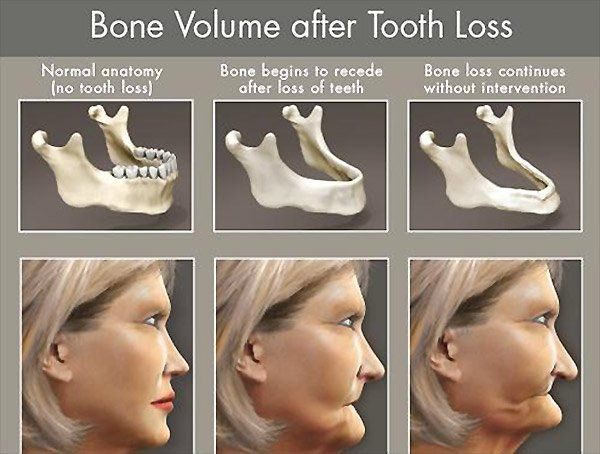
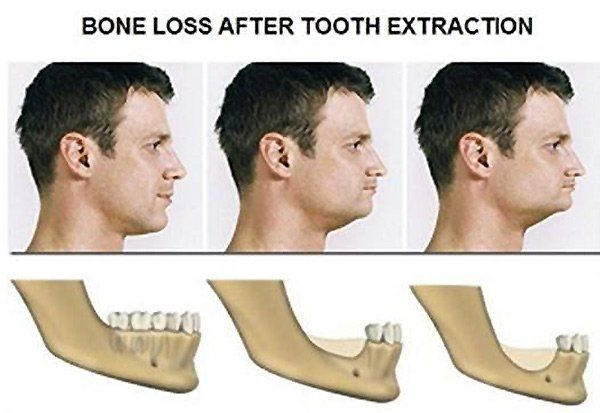
Replace Missing Teeth
We can use single implants to replace a lone missing tooth or multiple implants to replace more missing teeth. Generally when there are only a few missing teeth, those missing teeth are replaced with crowns or bridges on implants to provide a “fixed” non-removable solution.
For patients with no remaining teeth in an arch, we can give them a fixed solution using various materials so that it is just like having a 3rd set of non-removable teeth. One variation of this treatment has been popularized by the all-on-4 dental implant procedure where four implants are placed in a jaw and a denture is screwed in place as demonstrated below.
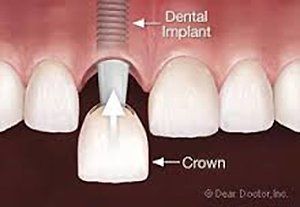
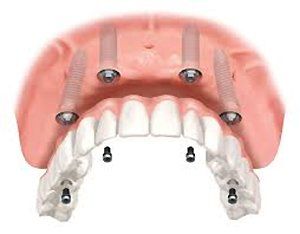
The number of implants actually required to replace missing teeth in a jaw is highly dependent upon each patient’s particular situation. There are also various tooth replacement material options available to secure to the implants as well
Retain a Partial or Complete Denture
When a patient has several missing teeth and is looking for a more economical option, we can use one or more implants in combination with a removable partial denture to be able secure the partial with a snap between the implant(s) and the partial denture. This allows the partial to be secured without the need for unsightly metal clasps surrounding the remaining teeth.
Another option for the completely edentulous arch is to use implants to retain and stabilize a complete denture with snaps in two or more implants. This option affords a thinner more comfortable upper denture where the palatal tissue can be left uncovered to better taste food and can stabilize a lose lower denture to gain confidence and be able to eat what one wants rather than only what one can.
